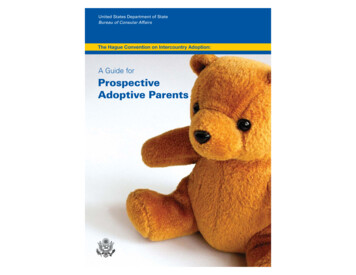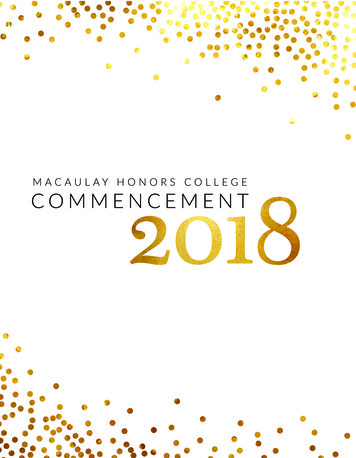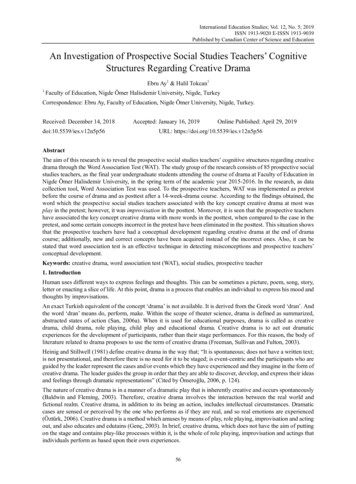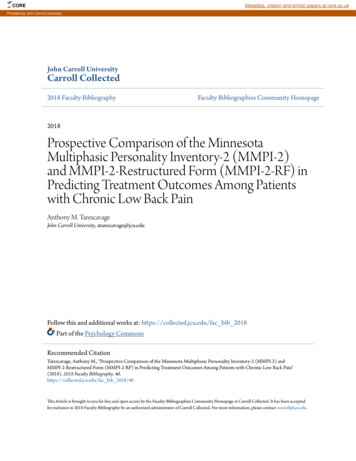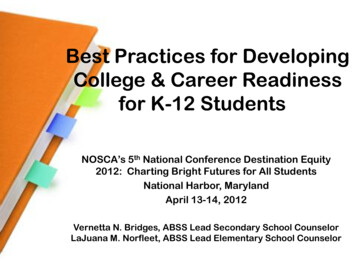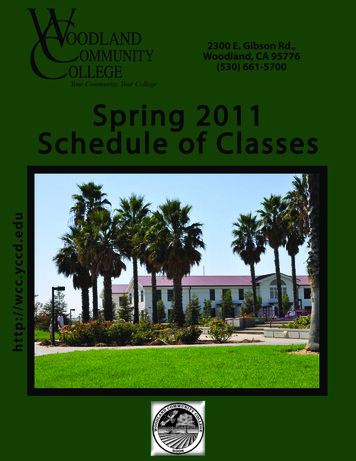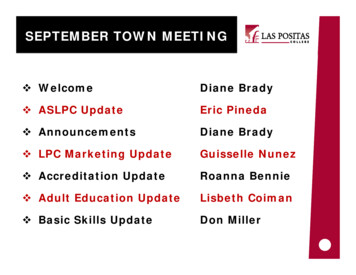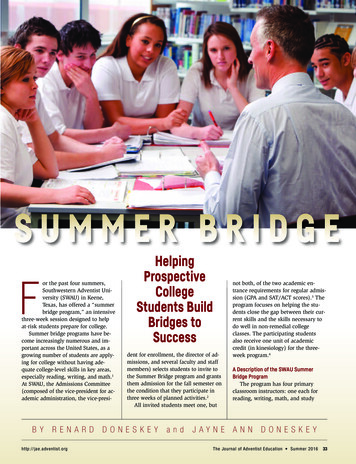
Transcription
or the past four summers,Southwestern Adventist University (SWAU) in Keene,Texas, has offered a “summerbridge program,” an intensivethree-week session designed to helpat-risk students prepare for college.Summer bridge programs have become increasingly numerous and important across the United States, as agrowing number of students are applying for college without having adequate college-level skills in key areas,especially reading, writing, and math.1At SWAU, the Admissions Committee(composed of the vice-president for academic administration, the vice-presi-FB YR E egeStudents BuildBridges toSuccessdent for enrollment, the director of admissions, and several faculty and staffmembers) selects students to invite tothe Summer Bridge program and grantsthem admission for the fall semester onthe condition that they participate inthree weeks of planned activities.2All invited students meet one, butD ONE SKE Yan dJAYNEnot both, of the two academic entrance requirements for regular admission (GPA and SAT/ACT scores).3 Theprogram focuses on helping the students close the gap between their current skills and the skills necessary todo well in non-remedial collegeclasses. The participating studentsalso receive one unit of academiccredit (in kinesiology) for the threeweek program.4A Description of the SWAU SummerBridge ProgramThe program has four primaryclassroom instructors: one each forreading, writing, math, and studyANNDONESKEYThe Journal of Adventist Education Summer 201633
Summer Bridge students visit the Fossil Rim Wildlife Center in Glen Rose, Texas, where more than 1,000 animals and 60 different speciesmake their home.skills. These instructors are regularSWAU faculty members who have aseparate summer contract for workingwith the program. Amy Rosenthal,vice president for academic administration, noted that “Faculty are chosenbased on the discipline and their interest in remediation. One of thestrengths of the program has been theconsistent participation of the originalgroup of faculty and staff, which hasallowed us to reflect on and adjustprogram components in an effectiveway.”5 Others involved in the programinclude a coordinator for reading andwriting, student tutors/mentors forboth the English and the math components, support staff from the Centerfor Academic Success and Advising(CASA) and other volunteers who assist in worships and field trips, comprising a total of approximately 13people working in the program. Thisnumber has remained stable for thethree years of the program, with consistent participation by the same classroom instructors and support staff.Modeled after the wholistic approachthat has proved successful in other summer bridge programs, the SWAU summer bridge program is designed to engage participants in all aspects of asuccessful college experience.6 The students, even those living close to campus, are required to live in the dormsand become a part of the campus life. Inaddition to courses that help them buildacademic skills in math, reading, andwriting, students learn much more: howto study for college-level exams, how toeliminate test anxiety, and how to payfor college (through financial advising),and how to form friendships and buildconnections to faculty members, staff,and administrators. In other words, thestudents’ ability to learn new materialin college is placed within a socialrealm—they learn in groups, in classes,with friends, and from others such as34 The Journal of Adventist Education Summer 2016peers or student mentors, as well asfrom teachers.Summer Bridge Program Based in SocialConstructivist TheoryThe interactions incorporated in thesummer bridge program are groundedin a social constructivist model oflearning, a wholistic approach derivedfrom the theories of the Russian developmental psychologist Lev Vygotsky,who said that the best learning is constructed by groups of learners in sociocultural environments.7 Vygotsky theorized that optimum learning happenswhen people work together in groupson meaningful tasks. A constructivistapproach8 frames the learning processin a building metaphor that involvesthe creation of knowledge through interactions by people with different perceptions and values.9 This conceptviews knowledge as constructed andcreated rather than being transferred,http://jae.adventist.org
transmitted, or copied. A constructivist frame for learning braids together activities such as reading, writing, speaking, and listening into theprocess of building knowledge ratherthan seeing them as separate skills.In keeping with this theoreticalframework, SWAU’s Summer Bridgeprogram focuses on three academicareas: math, reading, and writing, butalso incorporates worship, studyskills, and social interactions amongstudents, teaching faculty, staff, andadministrators. The students move asa cohort throughout their days in theprogram, and Summer Bridge personnel have noticed continued camaraderie among the Bridge students forthe rest of their freshman year.The weekly schedule includes fiveacademic days, plus an additional daydesignated for special social activities,such as field trips to places like the FortWorth Museum of Science, an animalreserve, a baseball game, a swimmingpool party, or a go-kart track (thesehave varied over the years, but we include about three such events eachsummer). On Sabbath, students participate in non-mandatory worship services and visit the homes of SummerBridge faculty members and administrators for food and social activities.The academic days begin with anearly breakfast at 7:30 a.m. in the student center where Summer Bridge faculty, staff, and administrators prepareand serve the food and present worship talks. After worship, the studentsspend an hour in physical exercise andthen attend classes and tutoring sessions in math, followed by lunch withtheir tutors and teachers in the university cafeteria. After lunch, they visitthe Center for Academic Support andAdvising (CASA), where they work onstudy skills and discuss various aspects of academic success. Later in theafternoon, they attend writing andreading classes and tutoring sessions.Each academic day ends between 5:00and 5:30 p.m., with the students having the evening for study, free time,planned activities, or socializing withtheir cohorts. In sum, the three-weekprogram contains 12 intensive academic days, one day each for pre-testshttp://jae.adventist.organd post-tests, and several days devoted to worship and social activities.The Results of the Enrichment ProgramEach student participating in theSummer Bridge program is given twotests at the beginning of the three-weeksession: the Maple test (math) and theNelson-Denny Reading Test (reading).At the end of the program, they takethree tests: the Maple, the NelsonDenny, and a writing sample test. Theirscores on these tests are then used indetermining the courses in which theywill enroll for the fall semester.During the 2013 program year,mathematics scores showed dramaticimprovement. The students’ Maplepost-test average was 8.28, quite a contrast to their pre-test average of 5.12, adifferential of 3.16.10 The average scoreincrease was 11.68 percent. Of the 23students in the 2013 enrichment program, 19 improved their math score.The improvement was similar forreading. The pre-test average on the Nelson-Denny Reading Test was 9.88,slightly below the sophomore highschool level.11 Some individuals scoredconsiderably lower. Nine of the 23 students were reading below the 9th-gradelevel before instruction began. The posttest average (after instruction) was 11.39,representing an average improvement ofslightly more than 1.5 grade levels. Forteachers who taught the reading course,these scores were very encouraging.In subsequent years, the results werevery similar, with the students showinglarge gains in both reading and mathskills. Table 1 shows the average studentimprovement in reading and math for allthree years of the program.Retention and the Summer BridgeProgramAccording to a study done on retention levels and summer bridge programs, “the strongest predictor for retention is passing a developmentalreading course. College-level readingcomprehension and reading strategiesare essential for students to be able toread and understand their college-leveltextbooks.”12 At Southwestern Adventist University, we have seen a similartrend. Our retention rate for the Year 1Summer Bridge cohort was 100 percent from fall to spring, 11 percentagepoints higher than the freshman classas a whole. Sixty-eight percent of the2013 cohort returned for their sophomore year, the same percentage as forthe regular-admission freshmen.This high rate demonstrates a number of important things. First, SummerBridge students achieve high enoughgrades in the fall semester that they areable and willing to continue in thespring. Second, the perfect retentionrate in 2013 indicates that these students find the environment at Southwestern Adventist University conduciveto pursuing their goals—even moreconducive than the average non-Bridgefreshman. Third, the “cohort” conceptbegun in Summer Bridge introducesstudents to campus life, and they enterTable 1. Summer Bridge Assessment Results*YearAssessment .620159.43.768.2411.4* Note: The reading test (Nelson-Denny) uses a grade-equivalency score; therefore, the 9.88score for the 2013 reading test represents the average student’s level (below the 10th grade).The math test (Maple) does not use a grade-equivalency scoring system.The Journal of Adventist Education Summer 201635
Summer Bridge students acquire skills essential for a successful college experience by collaborating with peers, working in groups, andlearning from others such as student mentors.the university with already-establishedfriendships and a study routine that enables them to succeed and stay inschool. In brief, the philosophicalframework of constructivist and wholistic principles works well in this Summer Bridge program, using the assessments of both grades and retention.Summer Bridge Students’ Success AfterParticipating in the ProgramWhat are students’ goals in attending a bridge program? In a study byWathington et al., the authors note:“Students commented during focusgroup sessions: ‘I didn’t want to takeany remedial classes,’ and ‘[my primary goal in the program was to] justget a higher grade and . . . not to takethe remedial classes.’”13 With this inmind, bridge students’ definition ofsuccess may differ from the institu-tion’s measures of success. In the firstSWAU Summer Bridge program (2013),two students out of 23 scored highenough on the post-instruction Mapletest to avoid remedial math, seven students avoided taking developmentalreading, and 11 students avoided remedial writing and entered a regularfreshman composition course.The 2013 Bridge students who wererequired to enroll in remedial courseshad good results in their remedialcourses, but mixed results in theirnon-remedial courses the remainder oftheir freshman year. Of the 23 students in the 2013 Bridge program, 12placed into RDNG 011 Developmental Reading; all of them passed thecourse. Of the students coming out ofSummer Bridge, 71.4 percent of thosewho took the remedial writing courseComposition Review received a gradeof C- or higher. Further, 83.3 percentof the Bridge students who took the36 The Journal of Adventist Education Summer 2016non-remedial freshman compositioncourse received a C- or higher. Clearly,the Summer Bridge program helpedstudents close their skills gap in reading and writing. In mathematics, 75percent of students who took the remedial algebra course passed the classwith a C- or higher; 40 percent of students who took the college-level algebra course got a C- or higher. In total,9.5 percent of the Summer Bridge students successfully completed a college-level math class with a C- orhigher within two semesters, excluding three students who withdrew.14While the success rate in math,when measured by a passing grade incollege algebra, is not high, 19 of the23 enrichment students had Maplepre-test scores of 5 or less, with 13 asthe cutoff score to get into regular college algebra. Students with very lowhttp://jae.adventist.org
math scores may simply not be remediated quickly enough to find success within a year of entering college, at least with the remediationinitially offered in the SummerBridge program.“My confidence inreading has grown a lotduring this classSummer Bridge and ContinuingAssessmentThe university, based on this 2013assessment, made modifications inboth subsequent Summer Bridge programs (2014 and 2015) and in theway math instruction had been delivered, starting with the fall 2014semester. SWAU increased its mathtutoring opportunities for the 20142015 school year and piloted a section of a college math course thatsupplements regular instruction withcomputer-aided instruction. Regarding overall academic success, asmeasured by GPA averages, we notedthat the average fall semester GPAfor the Summer Bridge students wasno different than the average GPA forthe regular-admission freshmen,though in the spring semester the average GPA (2.29) for the SummerBridge students was lower than theaverage GPA (2.93) for the regularadmission freshmen.Other tweaks were also made in theprogram based on our assessments. Several of these changes affect the non-academic elements of the program. Afterthe first year, we instituted a dorm roomcurfew of 10:30 p.m., as the studentstended to socialize (gathering in dormlobbies, for example) until very late atnight or even into the early morninghours, leaving them so fatigued by theafternoon classroom sessions that theyhad trouble staying alert. With the samecurfew in place the following summers,we noticed improved concentration during the afternoon sessions. Further, webegan offering fewer weekend socialevents, building in rest days, particularly on Sundays.Given the wholistic approach toSummer Bridge, we were also interested in the students’ own assessmentof their learning abilities. As Holschuhand Paulson note about literacy instruction: “We view postsecondaryliteracy instruction not as a set ofhttp://jae.adventist.orgbecause my boundarieshave expanded, and Ihave a better comprehension of the meaningbehind the words.The skills I have learnedin this class have helpedme very much in othercollege classes I am currently taking.”technical skills to learn, but as a constructive series of connections thattake place within the context of college. That is, this instruction takesplace in a social network in which students must be able to critically examine their role in the network and howto navigate this aspect of society.”15Part of our assessment of the program, then, addresses these issues ofnetworking and navigating the collegedomain. Beyond the standardized testscores, we also have evidence that thestudents succeeded on affective levelsas well. In reading courses, the students kept a reading journal. Beloware sample entries from late in the fall2013 semester as the students lookedback on their experiences in reading: “I was shy and now I feel comfortable because everyone in the classneeds help in the same things as meas well. I feel confident now to be ableto read.” “My confidence in reading hasgrown a lot during this class becausemy boundaries have expanded, and Ihave a better comprehension of themeaning behind the words. The skillsI have learned in this class havehelped me very much in other collegeclasses I am currently taking. I havebeen able not only to read but actuallycomprehend what lessons in textbooksare saying, and as a direct result mygrades have risen.” “Surprisingly enough, I read a lotmore now. I don’t know if that is because I never tried to read much inhigh school, but I have been reading alot more, and I don’t get tired quicklyof reading. I do believe between thisreading class and my writing class, Ihave become more open minded toreading for school. Now I can see myself as a moderate reader, and possiblyeven reading more for fun. A lot of theskills learned here in the class will bebrought over with me throughout mytime of schooling and further.”These sample comments reveal thatmost students not only improved ontheir test scores and made passinggrades, but also changed their attitudes. They began to see themselvesdifferently as readers and as students.This changed attitude continued withthe students as they moved throughtheir academic career. One student,now a sophomore, who attended theSummer Bridge program in 2014 noted:“My experience with Summer Bridgehas affected me greatly in my schooling. I was able to get more acquaintedwith the campus and some of the staff.I was able to see what some of my college classes might be like with thepreparatory classes in Summer Bridge. Iwas also able to have already accomplished the mindset needed for collegeway ahead of time before any of theother freshmen. I believe SummerBridge did prepare me well, and because of it I have been successful in allof my classes since then. Attending thisprogram also gave me a friend base thatotherwise wouldn’t have happened if Idid not attend this program.”16The Journal of Adventist Education Summer 201637
In his comments about the program, the previous student noted allthree areas we focus on during theSummer Bridge program: academicpreparation, involvement in campuslife, and the formation of friendshipsthat provide support.As Matthew Kilian McCurrie, an instructor in a summer bridge programat Columbia College in Chicago,stated:“Many of the young people whoenter Summer Bridge report that beingtreated like a student, like a readerand writer, was a first step for them indefining success and an important aspect of the Summer Bridge program.Part of the value in the Bridge program has always seemed to be its ability to draw in students who felt alienated or silenced in high school or intheir lives generally and give them aspace to reposition themselves as successful students.”17Clearly, summer bridge programsnot only improve students’ academicskills in math, writing, and reading,but also improve their attitudes aboutthemselves as well.Implications for Seventh-day AdventistInstitutionsBased on the information above,we can assert that the Summer Bridgeprogram at Southwestern AdventistUniversity has succeeded beyond ourexpectations. The students’ math,reading, and writing skills all improved. In each of the three summers,some students improved enough toavoid at least one remedial class. Themonetary benefit for some of thesestudents represents a savings of thousands of dollars, even taking into account the 400 fee18 for the SummerBridge program.Academically, then, for the university and for the students, the programsucceeded. But there is another measure of success worth noting. Thesewere students who, without SummerBridge, would not have been admittedinto Southwestern Adventist Univer-sity. We may well ask ourselves wherethey would have gone. With low standardized test scores and/or low highschool GPAs, it might have been difficult for them to get into any Seventhday Adventist college or university, orother four-year institution. In otherwords, if they hadn’t come to theSummer Bridge program, they probably would have gone to a communitycollege, trade school, or perhaps notcontinued with their education at all.As administrators and teachersthink about the mission of Adventistinstitutions, we should seek ways toaccept students who want to attend anAdventist institution even though theydon’t have college-level skills in allareas. Philosophically, we must findways to balance the issues associatedwith accepting such at-risk studentswith the mission of the AdventistChurch and the importance of keepingstudents in an Adventist environment.Further, we must consider how we canbest help such students succeed if wedo accept them into our colleges anduniversities. Southwestern AdventistUniversity’s Summer Bridge programhas been an important step in addressing some of these important questions.RecommendationsBased on our experiences at Southwestern Adventist University, we believe other Adventist institutionsshould consider implementing a summer bridge program. As Adventists,our ideal goal must always be to meetthe needs of students who desire aChristian education. But students applying to Adventist schools, like theircounterparts across the United States,are increasingly less academically prepared for college.19 Colleges and universities with no mission emphasis beyond offering high-quality educationface these same problems. Some havedecided to turn students away or to insist that they “get up to speed” beforeinitiating a transfer. Many other colleges and universities though, withoutany spiritual emphasis or calling at all,have created opportunities for studentsby creating summer bridge programs.How can we as Adventist educators doless? Our role as both educators and38 The Journal of Adventist Education Summer 2016Adventists is to help as many studentsas we can, and let them have a chanceat the opportunities that only a collegedegree can provide. Of course, we alsomust maintain high academic standards. A summer bridge program canhelp meet both these goals. This article has been peer reviewed.Renard Doneskey,Ph.D., is a Professor of English atSouthwestern Adventist University(SWAU) in Keene,Texas. He receivedhis doctorate fromthe University of California, Riverside.Now in his 17th year at the university,he has also taught at La Sierra University, Hebei Teachers’ College (in Hebei,China), and the University of California, Riverside. He has chaired the English departments at La Sierra Universityand Southwestern Adventist University,taught in the Honors Programs of bothschools, and directed the Honors Program at Southwestern for six years. Dr.Doneskey supervises the reading andwriting components of the SWAU Summer Bridge program. His current research interests include summer bridgeprograms and college reading.Jayne AnnDoneskey, M.A.,is an AssistantProfessor of English at Southwestern AdventistUniversity. She received her M.A. inElementary Education from La SierraUniversity, and has worked in the English and ESL departments of SWAU forthe past three years. Her love of reading instruction began while she was a1st- and 2nd-grade teacher at LomaLinda Elementary School and RedlandsJunior Academy in southern Califor-http://jae.adventist.org
nia. She has made recent presentationson reading at the Association of Literacy Educators and Researchers and theLiteracy Research Association. Mrs.Doneskey also teaches reading in theSWAU Summer Bridge program.NOTES AND REFERENCES1. Ray Fields, “Towards the National Assessment of Educational Progress (NAEP) asan Indicator of Academic Preparedness forCollege and Job Training” (2014): -preparedness-report.pdf;Kelsey Sheehy, “High School Students NotPrepared for College, Career” (2012): for-college-career. AllWebsites in the endnotes were accessed onJune 21, 2016.2. In 2013 through 2015, the program wascalled CORE Enrichment. Starting in thesummer of 2016, the bridge program will becalled Summer Bridge to more clearly differentiate it from regular freshman orientation.In this article, we refer to the program by itsnew name. The program costs the student 400 to attend, with additional funding coming from the Southwestern Union Conference, the university, and for the summer of2016, a grant from the Independent Collegesand Universities of Texas.3. The regular admissions standards required a high school GPA of 2.25, coupledwith a combined ACT score of 17 or a combined SAT score of 820.4. In the summer of 2013, 23 studentswere invited to attend the summer bridgeprogram; two other students also participated, though their standardized test scoresand GPAs would have allowed them regularadmittance. Their parents heard about theprogram and asked if they could attend toget a jump start on college. Therefore, a totalof 25 students participated in the program.In 2014, 23 students attended the program;and in 2015, 24 students attended.5. Amy Rosenthal, personal communication, March 4, 2016.6. See, for example, Heather Wathingtonet al., “Getting Ready for College: An Implementation and Early Impacts Study of EightTexas Developmental Summer Bridge Programs,” National Center for PostsecondaryResearch (October 2011): DSBReport.pdf.7. Lev Vygotsky, Mind in Society: The Development of Higher Psychological Processes(Cambridge: Harvard University Press,1978), pp. 79-91.8. For a discussion on the compatibilityof constructivism with Christianity, seehttp://jae.adventist.orgAustin C. Archer’s article, “Constructivismand Christian Teaching,” The Journal of Adventist Education 64:3 (February/March2002):32-39: 033208.pdf.9. Nancy Spivey, The ConstructivistMetaphor: Reading, Writing, and the Makingof Meaning (San Diego: Academic Press,1997), pp. 1-3.10. These figures represent a raw scoreand therefore cannot be compared to gradelevels. The Maple test uses a range from 125. Students with a score below 13 are enrolled in remedial math.11. The Nelson-Denny scores are reportedas a grade equivalency, meaning the gradelevel at which the students are reading(based on U.S. national averages). A 10.3score represents a student reading slightlyabove the 10th-grade level, or at the sophomore level in high school. A score of 13would mean that the student was reading atthe freshman level in college.12. David S. Fike and Renea Fike, “Predictors of First-year Student Retention in theCommunity College,” Community College Review 36:2 (October 2008):80.13. Wathington et al., “Getting Ready forCollege: An Implementation and Early Impacts Study of Eight Texas DevelopmentalSummer Bridge Programs,” op. cit., p. 37.14. To place these results in context, theremedial math class at SWAU had recentlybeen changed from a two-semester sequence(Introduction to Algebra and IntermediateAlgebra, with each course meeting five daysa week) to a one-semester course (CollegeAlgebra) meeting three days a week. Further,students had to make at least a C- in the current course to move into the non-remedialcollege algebra.15. Jodi Patrick Holschuh and Eric J.Paulson, “The Terrain of College Developmental Reading,” College Reading & Learning Association (July 2013): /TheTerrainofCollege91913.pdf.16. Jerome Poindexter, personal communication, March 14, 2016.17. The program fee of 400 includes accommodation in the residence halls andmeals at the university cafeteria; courses inmath, reading, and writing; one collegecredit in physical education; tutoring and career counseling; and social activities andfield trips.18. Matthew Kilian McCurrie, “MeasuringSuccess in Summer Bridge Programs: Retention Efforts and Basic Writing,” Journal ofBasic Writing 28:2 (2009):44.19. Fields, “Towards the National Assessment of Educational Progress (NAEP) as anIndicator of Academic Preparedness for College and Job Training,” op. cit.; Sheehy,“High School Students Not Prepared for College, Career,” op. cit.The Journal of Adventist Education Summer 201639
both the English and the math compo - nents, support staff from the Center for Academic Success and Advising (CASA) and other volunteers who as-sist in worships and field trips, com - prising a total of approximately 13 people working in the program. This number has remained stable for the three years of the program, with con -

